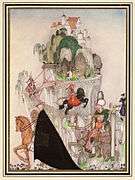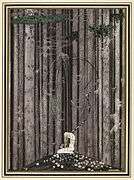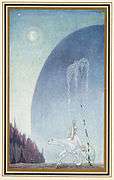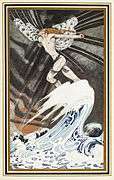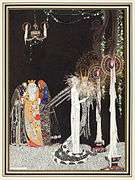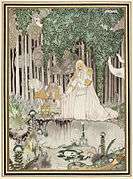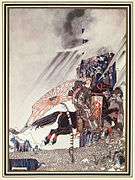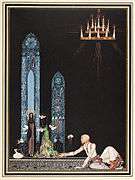East of the Sun and West of the Moon
"East of the Sun and West of the Moon" (Østenfor sol og vestenfor måne) is a Norwegian fairy tale.
"East of the Sun and West of the Moon" was collected by Peter Christen Asbjørnsen and Jørgen Moe. It is Aarne-Thompson type 425A, the search for the lost husband; other tales of this type include "Black Bull of Norroway", "The King of Love", "The Brown Bear of Norway", "The Daughter of the Skies", "The Enchanted Pig", "The Tale of the Hoodie", "Master Semolina", "The Sprig of Rosemary", "The Enchanted Snake", and "White-Bear-King-Valemon".[1] The Swedish version is called "Prince Hat under the Ground". It is related to both the tale of "Cupid and Psyche" in The Golden Ass and to "Beauty and the Beast".
It was included by Andrew Lang in The Blue Fairy Book.[2]
Synopsis
The White Bear approaches a poor peasant and asks if he will give him his prettiest and youngest daughter; in return, he will make the man rich. The girl is reluctant, so the peasant asks the bear to return, and in the meantime, persuades her. The White Bear takes her off to a rich and enchanted castle. At night, he takes off his bear form in order to come to her bed as a man, although the lack of light means that she never sees him.
When she grows homesick, the bear agrees that she might go home as long as she agrees that she will never speak with her mother alone, but only when other people are about. At home, they welcome her, and her mother makes persistent attempts to speak with her alone, finally succeeding and persuading her to tell the whole tale. Hearing it, her mother insists that the White Bear must really be a troll, gives her some candles, and tells her to light them at night, to see what is sharing her bed.
The youngest daughter obeys, and finds he is a highly attractive prince, but she spills three drops of the melted tallow on him, waking him. He tells her that if she held out a year, he would have been free, but now he must go to his wicked stepmother, who enchanted him into this shape and lives in a castle east of the sun and west of the moon, and marry her hideous daughter, a troll princess.
In the morning, the youngest daughter finds that the palace has vanished. She sets out in search of him. Coming to a great mountain, she finds an old woman playing with a golden apple. The youngest daughter asks if she knows the way to the castle east of the sun and west of the moon. The old woman cannot tell her, but lends the youngest daughter a horse to reach a neighbor who might know, and gives her the apple. The neighbor is sitting outside another mountain, with a golden carding comb. She, also, does not know the way to the castle east of the sun and west of the moon, but lends the youngest daughter a horse to reach a neighbor who might know, and gives her the carding-comb. The third neighbor has a golden spinning wheel. She, also, does not know the way to the castle east of the sun and west of the moon, but lends the youngest daughter a horse to reach the East Wind and gives her the spinning wheel.
The East Wind has never been to the castle east of the sun and west of the moon, but his brother the West Wind might have, being stronger. He takes her to the West Wind. The West Wind does the same, bringing her to the South Wind; the South Wind does the same, bringing her to the North Wind. The North Wind reports that he once blew an aspen leaf there, and was exhausted after, but he will take her if she really wants to go. The youngest daughter does wish to go, and so he takes her there.
The next morning, the youngest daughter takes out the golden apple. The troll princess who was to marry the prince sees it and wants to buy it. The girl agrees, if she can spend the night with the prince. The troll princess agrees but gives the prince a sleeping drink, so that the youngest daughter cannot wake him. The same thing happens the next night, after the youngest daughter pays the troll princess with the gold carding-combs. During the girl's attempts to wake the prince, her weeping and calling to him is overheard by some imprisoned townspeople in the castle, who tell the prince of it. On the third night, in return for the golden spinning wheel, the troll princess brings the drink, but the prince does not drink it, and so is awake for the youngest daughter's visit.
The prince tells her how she can save him: He will declare that he will not marry anyone who cannot wash the tallow drops from his shirt since trolls, such as his stepmother and her daughter, the troll princess, cannot do it. So instead, he will call in the youngest daughter, and she will be able to do it, so she will marry him. The plan works, and the trolls, in a rage, burst. The prince and his bride free the prisoners captive in the castle, take the gold and silver within, and leave the castle east of the sun and west of the moon.
Retellings and translations into English
- East o' the Sun & West o' the Moon, 1910, translated by Sir George Webbe Dasent and illustrated by the brothers Reginald L. Knowles and Horace J. Knowles
- East of the Sun & West of the Moon, 1914, translated by G. W. Dasent (1910), illustrated by Kay Nielsen
- East of the Sun & West of the Moon, 1980, written and illustrated by Mercer Mayer
- East o' the Sun & West o' the Moon, translated by G. W. Dasent (1910), illustrated by P. J. Lynch
- East of the Sun & West of the Moon, 1994, play by Tina Howe
- East of the Sun, West of the Moon, by D. J. MacHale, illustrated by Vivienne Flesher (Rabbit Ears Productions)
- Enchanted: East of the sun, West of the moon, by Nancy Madore
- "East of the Sun and West of the Moon," The Dancing Bears, 1954, by W. S. Merwin
- Once Upon a Winter's Night, 2001, by Dennis L. McKiernan
- East, 2003, novel by Edith Pattou
- Sun and Moon, Ice and Snow, 2009, by Jessica Day George
- Ice, 2009, novel by Sarah Beth Durst
Film adaptations
- In the early 1980s Don Bluth Productions began work on an animated feature film entitled East of the Sun and West of the Moon.[3][4] Ultimately, the film was never made due to a loss of financial backing,[5] even though the film was heavily into production at the time of its cancellation.[6]
- Rabbit Ears Productions East of the Sun, West of the Moon Max von Sydow narrates the Rabbit Ears Productions version of this story. Musical accompaniment by Lyle Mays
- The Storyteller featured an episode called, "The True Bride", which was directly based on a German folktale of the same name, but referenced this story in its ending. Two female trolls separate the heroine from her husband in a similar way as the trolls from "East of the Sun and West of the Moon". The heroine's love is bewitched by a troll princess into forgetting her, but he is told the truth from the princess's prisoners. In the episode "Hans My Hedgehog" the husband also turns from a beast into a human.
Illustrations by Kay Nielsen in East of the sun and west of the moon (1914)
| Wikimedia Commons has media related to East of the sun and west of the moon. |
See also
- Cupid and Psyche
- Pintosmalto
- The Singing, Springing Lark
- The Two Kings' Children
- The Feather of Finist the Falcon
- The Three Daughters of King O'Hara
- The Three Princesses of Whiteland
- J. R. R. Tolkien's use of this phrase
References
- ↑ Heidi Anne Heiner, Tales Similar to East of the Sun and West of the Moon
- ↑ Andrew Lang, The Blue Fairy Book, "East of the Sun and West of the Moon"
- ↑ John Grant, p 35, Masters of Animation, ISBN 0-8230-3041-5
- ↑ John Culhane, "Special Effects Are Revolutionizing Film"
- ↑ "Newswatch: Bluth animation film goes bankrupt," The Comics Journal #98 (May 1985), p. 19.
- ↑ Jerry Beck, "Don Bluth Goes Independent"
External links
| Wikisource has original text related to this article: |
- Sur La Lune, annotated version of East of the Sun and West of the Moon
- East of the Sun and West of the Moon in full length
- Asbjørnsen, Peter Christen; Moe, Jørgen (1899). "41 Østenfor Sol og vestenfor Manne". Norske folke-eventyr. Volume 2. Kristiania: Aschehoug.
